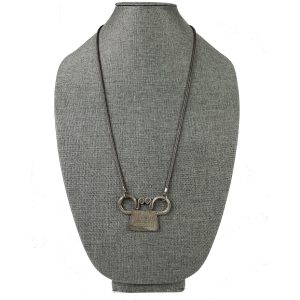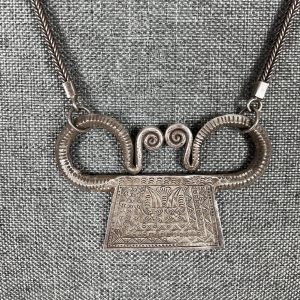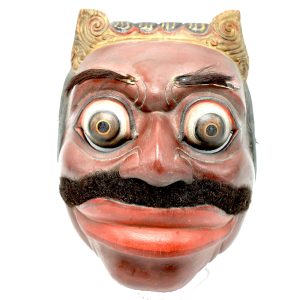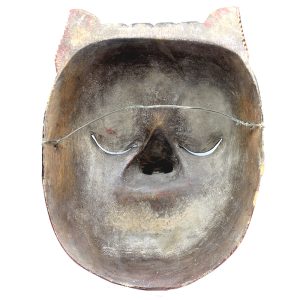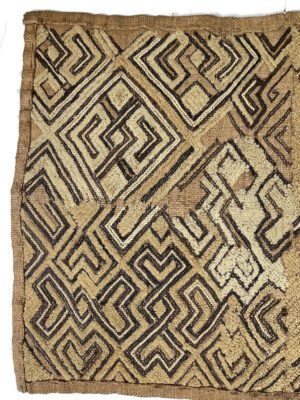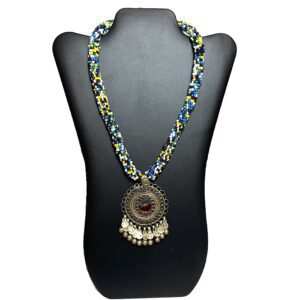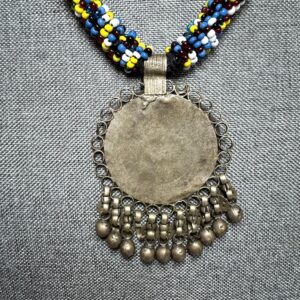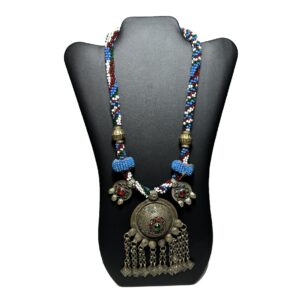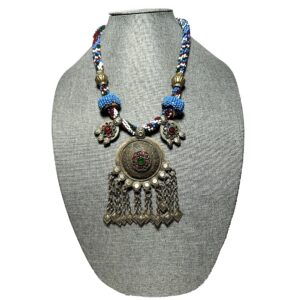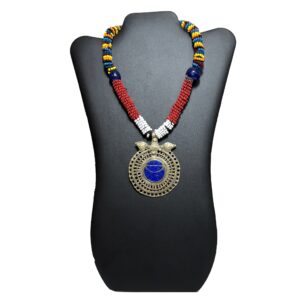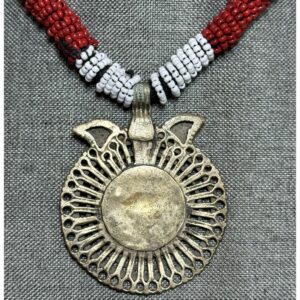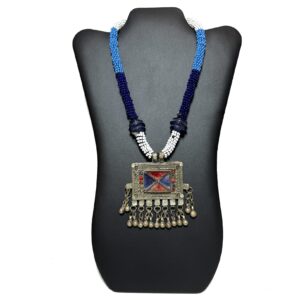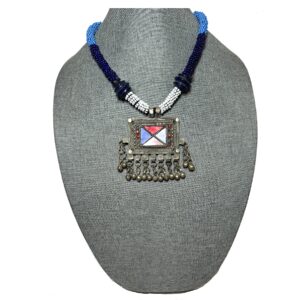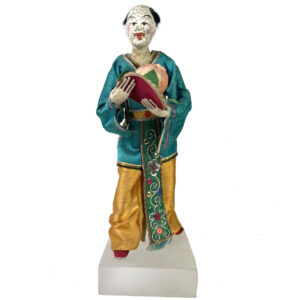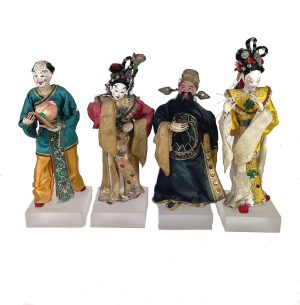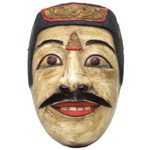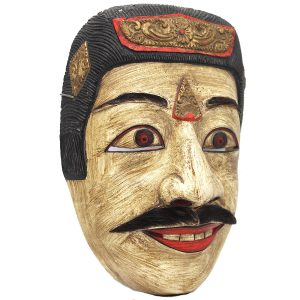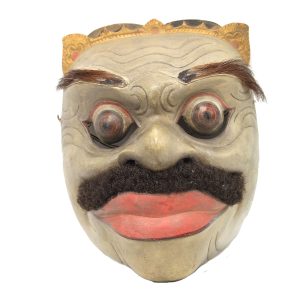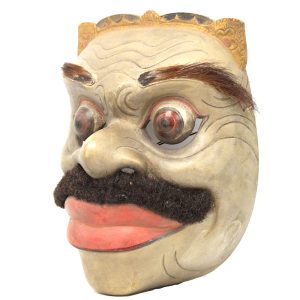Showing 397–408 of 430 results
-
Sale!


$325.00 Original price was: $325.00.$295.00Current price is: $295.00.
Chain: 28″ Pendant H: 1.75 ” W: 2.6″ D: .125″ | FREE SHIPPING WITHIN CONTINENTAL U.S.!
This hand made Hmong “spirit lock” pendant amulet necklace was made with high-grade silver, worn as a protective talisman to “lock in” protective spirits. This trapezoid-shaped pendant is engraved with traditional Hmong motifs – dots, triangles, curved and lines within geometric sections, centered with two 4-leaf flowers and topped by spirals that may represent elephant trunks or coiled snakes. Talismans like this are worn as protective amulets soon after birth.
-


$1,050.00
Javanese Wayang (puppet theater) Topeng (literally “pressed against the face” or mask) is a very refined dance form accompanied by gamelan music. In Bali Topeng tua is the charming dance of an old courtier’s fragile movements, his lack of control and his gathering energy for a short lively dance. He sits behind a cloth curtain,…
-


$125.00
This ethnic and folk-art Bali legendary court minister (topeng patih) is performed in a special mask dance named Topeng Panjegan, as only one dancer interprets five different characters wearing full face masks preventing speech. Patih manis (Sweet Minister) is often the first solo dance after a gamelan orchestra introduction, and this patih keras (strong minister)…
-
Sale!


$95.00 Original price was: $95.00.$75.00Current price is: $75.00.
H: 18″ W: 18″ | FREE SHIPPING WITHIN CONTINENTAL US
Woven from strands of raffia palm leaves, this traditional vintage bordered square Kuba cloth from the Democratic Republic of the Congo was made using vegetable dye and is embellished with sophisticated embroidered, applique and patchwork linear designs.
-
Sale!


$95.00 Original price was: $95.00.$75.00Current price is: $75.00.
H: 18″ W: 18″ | FREE SHIPPING IN CONTINENTAL US!
Woven from strands of raffia palm leaves, this traditional vintage bordered square Kuba cloth from the Democratic Republic of the Congo was made using vegetable dye and is embellished with sophisticated embroidered, applique and patchwork linear designs.
-
Sale!


$135.00 Original price was: $135.00.$115.00Current price is: $115.00.
Lenght: 20.5″ | FREE SHIPPING WITHIN CONTINENTAL U.S.
One-of-a-kind necklace with vintage coin silver alloy Kuchi tribal pendant with a red glass center and dangles worn create a loud festive jingle from dancers wearing it suspended on hand strung beaded ornamental chain.
-
Sale!


$175.00 Original price was: $175.00.$135.00Current price is: $135.00.
Chain Length: 22″ | FREE SHIPPING WITHIN CONTINENTAL U.S.
Vintage Kuchi pendant, dome center, incised dangles and 2 vintage coins used to create festive jingle on dancers wearing it. Suspended on hand strung beaded ornamental chain to create a one-of-a-kind fashion statement.
-
Sale!


$135.00 Original price was: $135.00.$115.00Current price is: $115.00.
Chain Length: 18″ | FREE SHIPPING WITHIN CONTINENTAL U.S.
One-of-a-kind necklace with vintage Kuchi tribal Turkmen round pendant with lapis center and elaborate cut out designs, suspended on hand strung beaded ornamental chain to create a unique and colorful fashion piece..
-
Sale!


$135.00 Original price was: $135.00.$115.00Current price is: $115.00.
W: 19″ chain | FREE SHIPPING WITHIN CONTINENTAL U.S.
Vintage large square Kuchi tribal coin silver alloy pendant, intricate design, with blue and red inset glass and dangles to create jingle for dancers. Hanging from a hand strung beaded ornamental chain, it is a one-of-a-kind fashion statement.
-
Sale!


$195.00 Original price was: $195.00.$135.00Current price is: $135.00.
H: 9.25″ W: 3.125″ D: 3″ | Free SHipping within continental u.s.
Vivacious attendant doll offering huge peach in vibrant Chinese dance costume in red, yellow, green-blue with sequins, silver and gold thread and plum blossoms as wish for Five Happinesses. On Lucite stand, part of set of 4 .
-


$105.00
All ethnic mask (topeng) dances in Bali are accompanied with music from a gamelan percussion orchestra as are dramas and other entertainments considered as offerings to honor, please and attract the favor of the gods and ancestral spirits. In the west dancers put on masks to pretend they are someone else. Balinese dancers become the…
-


$125.00
Court ministers (patih) in Bali, Indonesia are danced in mask (topeng) performances named Topeng Panjegan where a single dancer interprets 5 legendary characters wearing full face masks, cannot speak and much portray them only through gestures and body language and positions. Patih manis (literally sweet, a good natured, diplomatic minister) is often the first solo…
End of content
End of content

